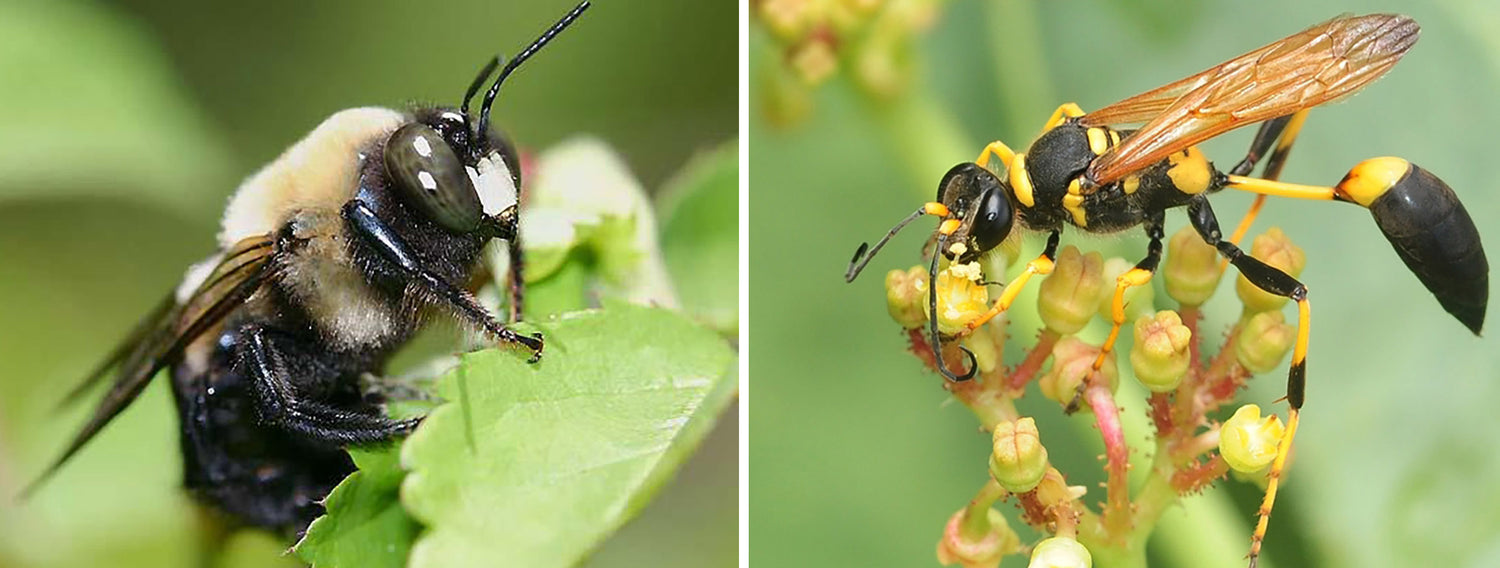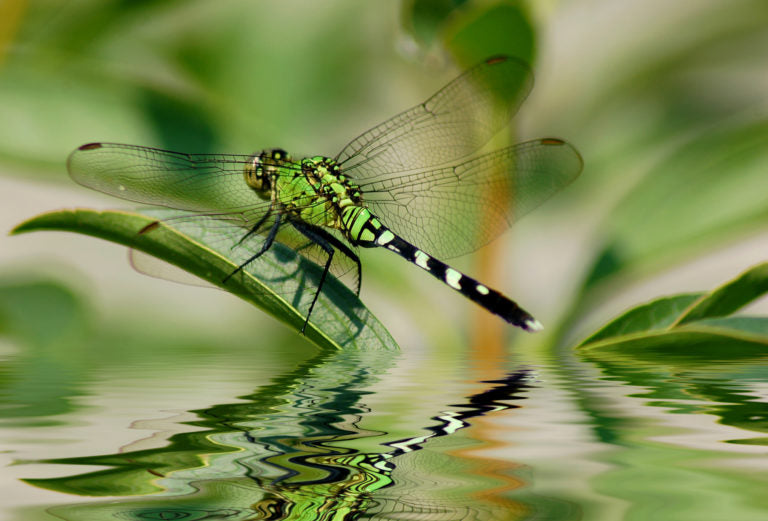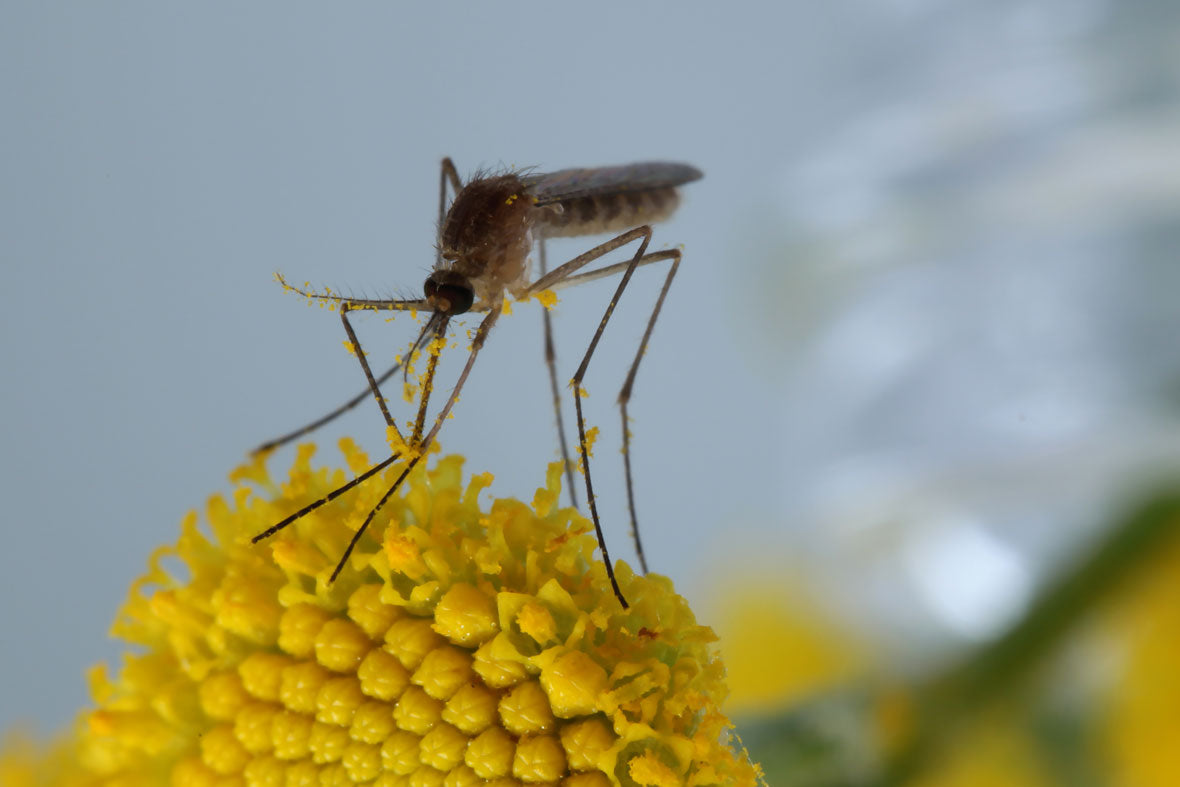Are They Carpenter Bees or Mud Daubers?
Not sure what’s buzzing around your property? We get this question a lot, so let’s take a look at how to identify each. To control wood-boring bees, our carpenter bee traps are highly effective, but ONLY for catching carpenter bees!

What Does a Carpenter Bee Look Like?
First of all, they are BIG! Carpenter bees are typically one inch long. They are often confused with bumblebees. Male and female carpenter bees look similar, but there are distinct markings to help you tell them apart.
Both have black heads, but the male has a light marking on his face. The carpenter bee’s thorax is covered in short yellow hairs with a small central bald spot. They have smooth, glossy black abdomens1. You may be wondering whether it’s safe to take a closer look. Despite their destructive behavior, carpenter bees rarely sting. The males are the guys buzzing around trying to protect the nest, but they are unable to sting. The females are busy boring holes into your house. They are able to sting if aggravated, but they generally do not.
What Does a Mud Dauber Look Like?
Mud daubers, like carpenter bees, are solitary, but they are not bees at all. Instead, they belong to the wasp family. Unlike the round carpenter bee, wasps are characteristically long and slender with a very thin “waist” between the thorax and the abdomen (the inspiration for the term “wasp-waist”)2. Both the black and yellow mud dauber (Sceliphron caementarium) and the organ-pipe mud dauber (Trypoxylon politum), which is black in color, build mud nests for their young. They often take up residence on the sheltered parts of buildings.
Blue mud daubers (Chalybion californicum), known for preying on the fearsome black widow spider, are parasitic. Instead of building their own nests, they use water from nearby puddles to soften the nests of other mud daubers, especially the black and yellow mud dauber, and break in. Then they remove the eggs, insert their own, and reseal the opening.3

Still can’t tell whether you have carpenter bees or mud daubers? Carpenter bee behavior offers more clues.
Carpenter Bee Behavior
Because they are solitary, carpenter bees don’t belong to a hive or participate in swarms. No group activities for these guys! And unlike mud daubers, which create nests from – you guessed it! – mud, they are the ones drilling holes into usually untreated wood around your home. Their nests are called galleries. The telltale sign of carpenter bee activity is the entry hole, a nearly perfect circle about a half inch in diameter. The hole is about one to two inches deep and then makes a perpendicular turn, running with the wood grain for up to six inches.4 Dust around the hole is a sign of a fresh infestation.
Controlling Carpenter Bees and Removing Mud Dauber Nests
Once you’ve identified what’s buzzing around your home, how do you eliminate the problem?
To remove a mud dauber nest, you won’t need special tools. According to the entomologists at Purdue University’s extension program, mud daubers don’t defend their nests. So you can scrape them off without fear of being stung!

For carpenter bees, you’ll want to focus on trapping existing bees and preventing future infestations.
We can help you catch those pesky carpenter bees and seal up their nests before they do further damage. Check out our Carpenter Bee Traps and Total BEE-Fense Kit to take back control of your home without toxic chemicals!
- Michael F. Potter, “ENTFACT-611: Carpenter Bees,” University of Kentucky College of Agriculture, revised September 7, 2018, https://entomology.ca.uky.edu/ef611.
- Timothy J. Gibb, “Solitary Bees and Wasps: Carpenter Bee, Cicada Killer, and Mud Daubers,” December 2016, Purdue University Extension, https://extension.entm.purdue.edu/publications/E-63/E-63.html
- Zoe Statman-Weil and Vicki Wojcik, “ The Blue Mud Wasp (Chalybion californium),” US Forest Service, accessed November 19, 2021, https://www.fs.fed.us/wildflowers/pollinators/pollinator-of-the-month/blue-mud-wasp.shtml.
- Gibb, “Solitary Bees and Wasps.”









Leave a comment
All comments are moderated before being published.
This site is protected by hCaptcha and the hCaptcha Privacy Policy and Terms of Service apply.